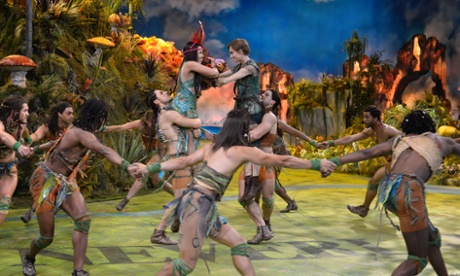
Hatchet in hand, stalking through the forest, Tiger Lily has made dramatic entrances ever since she first crept into JM Barrie’s script and signalled to the band of Braves at her back: “Pirates!”
Little did Barrie know, however, that the princess of Neverland would prove harder to pin down than Hook, the Lost Boys or even Peter Pan. A female leader in a fairy tale land or a symbol of an old and rooted racism? As Peter Pan productions come and go, from NBC’s live version to a forthcoming film starring Rooney Mara, the question persists: just who is Tiger Lily?
Barrie invented her with popular adventure stories in mind, penny dreadfuls that treated Native Americans fancifully, to say the least. Thoughts of racial insensitivity did not intrude on his Victorian sensibilities.
In the 1904 play and 1911 novel that brought Peter Pan to fame, Barrie calls Tiger Lily a princess of a “Piccaninny tribe”. She has all the trappings we now recognize from the worst sort of Native American stereotype. Tiger Lily puts her ear to the earth, breaks out a peace pipe, and speaks with her cohorts in guttural gibberish. Most uncomfortably, Barrie is not only prolific with the word “redskin” but also has Tiger Lily rapturously declare Peter “the Great White Father”, after he saves her life.
There is, however, “something about Peter that captivated everyone and let Barrie get away with a lot”, said Anne Hiebert Alton, a professor at Central Michigan University and the editor of a scholarly edition of Peter Pan. From Barrie’s perspective, she said, the world divided easily between the British and everyone else.
“He’s not being consciously racist,” she said. “But we still can’t let him off the hook.”
Barrie’s works do stink of their era. He turns Tiger Lily into a hero but makes sure she is subservient to Peter; he treats her tribe as better than the true enemy (pirates, adults) but not nearly as important as the heroes (boys, kids, not girls). Alton also pointed out that Barrie died in 1937 – long before anyone thought to take issue with his portrayal of Native Americans.
“There was an awful lot of white privilege going on in North America and in Britain at that time,” she said.
In 1953, Disney released its version of the story, complete with broad-nosed, red-faced men whose musical number, “What Made the Red Man Red”, is exactly as alarming to modern eyes and ears as its title suggests. A year later, director Jerome Robbins rejected the entire premise of diversity and cast the very blonde Sondra Lee to perform “Ugg-a-Wugg” in his musical – a drum number of caricatured dance moves and lyrics of inarticulate babble.
By the 1990s, culture had caught on that something was amiss. Steven Spielberg cut Tiger Lily out of 1991’s Hook; the 2003 film Peter Pan starred Carsen Gray, an actor of Haida descent; and the 2011 miniseries Neverland featured Q’orianka Kilcher, a German actor with a Quechua father, as Tiger Lily. The movie and miniseries treat Neverland’s princess and people carefully, with both more explicit fantasy and a respect for the actual Native Americans of the world.
Then, in 2013, Johnny Depp doused himself in makeup to play a monosyllabic Tonto for The Lone Ranger, and the debate about race began anew. Director Joe Wright fed the flames of outrage when he cast Rooney Mara, the white daughter of a wealthy American family, as Tiger Lily in his new Pan adaptation. Some Native Americans see caricature after caricature.
Ruth Hopkins, a Native American activist and writer, said she struggled “to find a way that Peter Pan could be ‘fixed’ so as not to offend Native peoples”. Hopkins told the Guardian the portrayals of Native Americans in Peter Pan vacillate wildly between “practically cavemen” and “the hipster version where we’re naked, sexy and wearing little more than a headdress”. Tiger Lily’s flaws begin with Barrie’s writing, she said, adding that it was long past time for culture to treat Native Americans as a diverse, vital and important part of society.
About the preponderance of white actors playing non-white roles, she was blunt: “If non-Natives dress up as Native people, it’s redface.”
Jerod Impichchaachaaha’ Tate, a Chickasaw composer who was hired by NBC to help adapt the musical for live TV this week, said he saw progress. NBC’s production featured Alanna Saunders, who claims Cherokee descent, as Tiger Lily and cut “Ugg-a-Wugg”. Tate called the decision to replace the song “very natural”.
“If you’re going to reboot certain musicals, you’re going to have to redress certain things,” he said, noting that the whole genre of musical theater was rife with stereotypes: “Grease, Ms Saigon, Les Miserables – as we go back in time the misrepresentation gets worse and worse.”
But Tate saw no cause to despair, describing the original Pan as “a cultural artifact” of its time, place and purpose. No one should expect much historical accuracy from a musical or fairy tale, he said, suggesting that however outrageous the sins of Barrie or Disney – the latter he said was “really outrageous” – “it’s a personal choice, and in 50 years we’re going to look back at all these films and be shocked all over again.”
For Tate and like-minded critics, Tiger Lily is only as static as each person and culture that re-creates her, “and even as a culture we do grow and get better”. Barrie himself tinkered with Neverland until 1928. Tiger Lily may yet steal the spotlight from the boy with the world’s most famous case of arrested development – a sign that the story and its readers are finally growing up.

